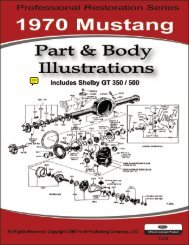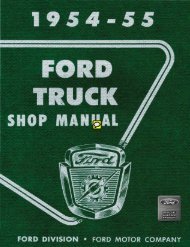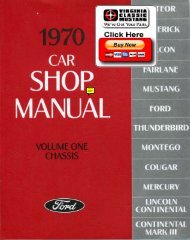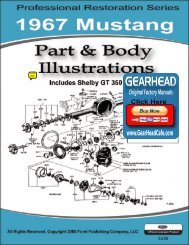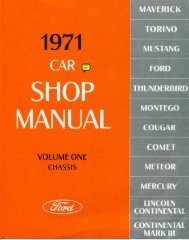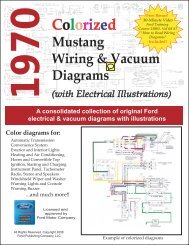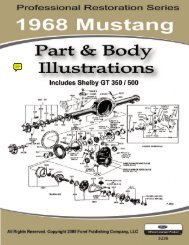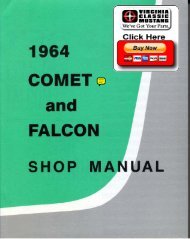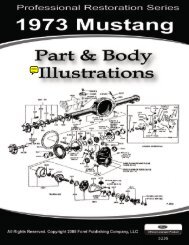DEMO - 1965 Ford Truck Shop Manual - ForelPublishing.com
DEMO - 1965 Ford Truck Shop Manual - ForelPublishing.com
DEMO - 1965 Ford Truck Shop Manual - ForelPublishing.com
Create successful ePaper yourself
Turn your PDF publications into a flip-book with our unique Google optimized e-Paper software.
2-34 GROUP 2 - BRAKES<br />
the release bolt nut bottoms (approximately<br />
18 turns).<br />
3. To avoid possible injury, be<br />
sure that the actuating spring is<br />
mechanically <strong>com</strong>pressed before<br />
removing the clamp ring. Remove<br />
the clamp bolt, expand the clamp<br />
ring, and slide it off the Fail-Safe<br />
and non-pressure housings.<br />
4. Remove the Fail-Safe unit from<br />
the non-pressure housing.<br />
INSTALLATION<br />
1. If the diaphragm is worn or<br />
damaged, replace it. Check the<br />
wedge assembly to be sure that the<br />
parts have not been disengaged during<br />
disassembly. Be sure that the<br />
wedge rod fits into the socket of the<br />
diaphragm plate and push rod assembly<br />
(Fig. 8).<br />
2. Install the diaphragm against<br />
the plate and push rod assembly,<br />
and mount the Fail-Safe unit against<br />
the diaphragm and non-pressure<br />
housing. Secure the Fail-Safe unit to<br />
the non-pressure housing with the<br />
clamp ring. Tighten the clamp ring<br />
bolt and nut, then install the warning<br />
tag.<br />
3. Turn the release bolt counterclockwise<br />
(approximately 18 turns)<br />
to release the manual <strong>com</strong>pression<br />
of the actuating spring.<br />
4. Start the engine and <strong>com</strong>pressor<br />
to build up system pressure for air<br />
<strong>com</strong>pression of the spring.<br />
MAJOR REPAIR OPERATIONS<br />
MAXIBRAKE<br />
DISASSEMBLY<br />
Before disassembling the brake<br />
chamber, mark both the pressure<br />
plate and cylinder assembly with<br />
relation to the clamping ring and<br />
the air line fittings, so that the unit<br />
can be reassembled in the same<br />
position. This will eliminate the possibility<br />
of installation interference<br />
and assure correct positioning of<br />
the air line fittings.<br />
1. Remove the clevis yoke and<br />
the flanged nut from the push rod<br />
and install a Z A inch OD x s /a inch<br />
ID flat washer and a s /s NF nut on<br />
the push rod—tighten the nut until<br />
the plate end of the push rod is<br />
seated on the safety piston spring<br />
SERVICE BRAKE<br />
AIR INLET<br />
SAFETY<br />
PISTON<br />
O-RING<br />
SEALS<br />
SERVICE \ PUSH ROD<br />
PISTON SAFETY PISTON SEAL<br />
AND SPRING SEAT<br />
PUSH ROD<br />
ASSEMBLY<br />
RING<br />
FIG. 9-Maxibrake-Sectional View<br />
support. It is necessary to <strong>com</strong>press<br />
the push rod return spring and the<br />
safety piston spring, so the unit may<br />
be disassembled safely without spring<br />
pressure on the safety piston spring<br />
support, and the diaphragm and<br />
pressure plate assembly (Fig. 9).<br />
2. Remove the clamp ring, pressure<br />
plate, and the service diaphragm<br />
from the cylinder assembly.<br />
3. Remove the eight cap screws<br />
that secure the safety piston spring<br />
support to the cylinder body and remove<br />
the <strong>com</strong>plete inner assembly.<br />
4. Set the push rod and piston<br />
assembly on a work bench and unthread<br />
and remove the nut and<br />
washer used to <strong>com</strong>press the springs.<br />
With the spring tension removed,<br />
disassemble the push rod, return<br />
SAFETY<br />
PISTON<br />
J<br />
SAFETY CHAMBER<br />
AIR INLET<br />
MOUNTING<br />
STUD<br />
CHAMBER<br />
H1255-A<br />
spring, safety piston, safety piston<br />
spring, and the spring seat.<br />
5. Remove the push rod seal<br />
from the bore of the piston and remove<br />
the O-ring seals from the piston<br />
and the cylinder.<br />
ASSEMBLY<br />
Always be sure that the correct<br />
return spring is used in any brake<br />
chamber. Also be sure that the brake<br />
chamber on the opposite side of the<br />
axle has the same return spring;<br />
otherwise uneven braking will result<br />
If a new diaphragm is installed in<br />
the brake chamber on one side of the<br />
axle, a new one should be installed in<br />
the corresponding brake chamber on<br />
the opposite side also; otherwise uneven<br />
braking may result.<br />
1. Coat the safety piston and the<br />
inside of the cylinder assembly with<br />
a light coat of Lubriplate or other<br />
suitable lubricant.<br />
2. Rest the push rod upright on a<br />
flat surface and assemble in order—<br />
the push rod return spring, safety piston<br />
spring seat and spring, and the<br />
safety piston. Compress the push rod<br />
and safety piston springs by installing<br />
the nut and flat washer used in<br />
the disassembly procedure.<br />
3. Install the push rod seal in the<br />
piston bore and install the O-ring<br />
seals on the piston and in the cylinder<br />
assembly.<br />
4. Position the piston and spring<br />
assembly into the cylinder assembly.<br />
Align the threaded holes in the safety<br />
piston spring support with the holes<br />
in the side of the cylinder, and install<br />
the retaining cap screws.<br />
5. Position the diaphragm and<br />
pressure plate with the clamp ring<br />
to the cylinder assembly, align the<br />
marks made prior to disassembly and<br />
tighten the clamp ring.




